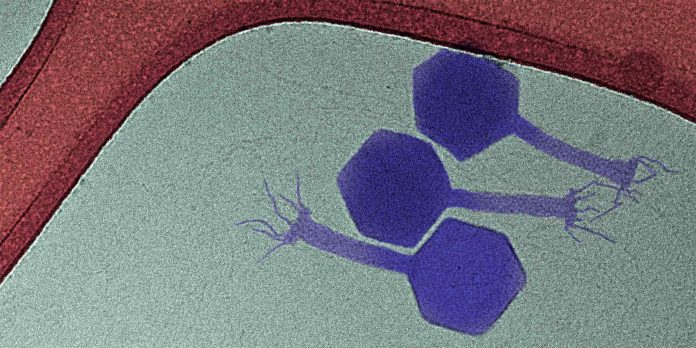Bacterial dormancy is survival strategy in response to stressful exposure to antibiotics taken by a patient for treatment. The dormant cells become tolerant to antibiotics and are killed at slower rate and survive sometimes. This is called ‘antibiotic tolerance’ which is unlike antibiotic resistance when bakterya grow in the presence of antibiotics. Chronic or relapsing infections are attributed to antibiotic tolerance, for which there is no effective treatment. Phage therapy has long been considered but the dormant bacterial cells are non-responsive and refractory to known bacteriophages. Scientists of ETH Zurich have identified a new bacteriophage that uniquely replicates on deep stationary-phase cultures of Pseudomonas aeruginosa. Named ‘Paride’, this bacteriophage could kill deep-dormant P. aeruginosa by direct lytic replication. Interestingly, this novel phage reduced bacterial loads through phage-antibiotic synergy when meropenem antibiotic was added to cultures. Apparently, the novel phage could exploit weak spots in the physiology of dormant bacteria to overcome antibiotic tolerance. These weak spots could be targets of new treatment for chronic infections caused by dormant or inactive bacteria.
Most bacteria on Earth are in dormant state of reduced metabolic activity or in completely inactive form of spore. Such bacterial cells can be readily resuscitated when required nutrients and molecules become available.
Bacterial dormancy or inactivity is the survival strategy in response to stressful external environmental conditions like starvation or exposure to antibiotics taken by a patient for treatment. In later case, the dormant cells become tolerant to antibiotics because cellular processes targeted by the antibiotics to kill bakterya are turned down. This phenomenon is called ‘antibiotic tolerance' kung saan ang bakterya ay pinapatay sa mas mabagal na rate at nabubuhay kung minsan (hindi katulad sa kaso ng antibyotiko paglaban kapag lumalaki ang bakterya sa pagkakaroon ng mga antibiotics). Ang mga talamak o umuulit na impeksyon ay nauugnay sa mga natutulog na antibiotic-tolerant na bacterial cell, na kadalasang tinutukoy bilang "nagpapatuloy", kung saan walang epektibong paggamot.
Phage therapy involving bacteriophages or phages (i.e., virus that predate bakterya), has long been considered for treating chronic infections by dormant or inactive bakterya however this approach works when host bacterial cells are undergoing growth. The dormant or inactive bacterial cells, however, are non-responsive and refractory to the bacteriophages which either avoid adsorption to the bacterial cell surfaces or hibernate in the dormant cells until resuscitation.
Known bacteriophages do not have ability to infect antibiotic-tolerant, deep-dormant or inactive bakterya. It was thought that given diversity, phages with ability to infect dormant cells may exist in nature. Researchers have now identified one such novel bacteriophage for the first time.
Sa isang kamakailang nai-publish na pag-aaral, ang mga siyentipiko ng ETH Zurich mag-ulat ng paghihiwalay ng isang bagong bacteriophage na katangi-tanging gumagaya sa malalim na nakatigil-phase na kultura ng Pseudomonas aeruginosa sa laboratoryo. Pinangalanan nila ang bacteriophage na ito Paride. Ang phage na ito ay maaaring pumatay ng deep-dormant P. aeruginosa sa pamamagitan ng direktang lytic replication. Kapansin-pansin, binawasan ng nobelang phage na ito ang bacterial load sa pamamagitan ng phage-antibiotic synergy nang idinagdag ang meropenem antibiotic sa P. aeruginosa-mga kultura ng phage.
Tila, ang nobelang phage ay maaaring samantalahin ang mga mahihinang lugar sa pisyolohiya ng mga natutulog na bakterya upang madaig ang pagpapaubaya sa antibiotic. Ang mga mahihinang spot na ito ay maaaring maging target ng bagong paggamot para sa mga malalang impeksiyon na dulot ng natutulog o hindi aktibong bakterya.
***
Sanggunian:
- Maffei, E., Woischnig, AK., Burkolter, MR et al. Maaaring patayin ng Phage Paride ang natutulog, antibiotic-tolerant na mga cell ng Pseudomonas aeruginosa sa pamamagitan ng direktang lytic replication. Nat Commun 15, 175 (2024). https://doi.org/10.1038/s41467-023-44157-3
***






































